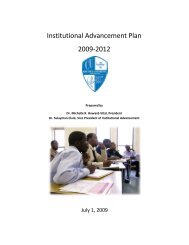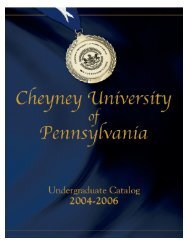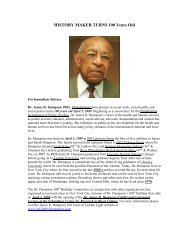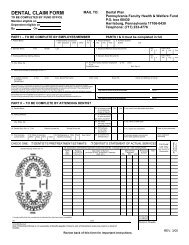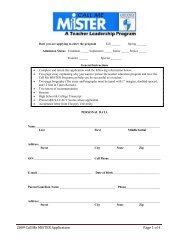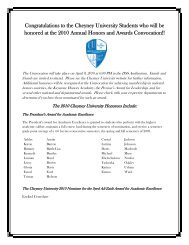campus security and fire safety report - Cheyney University of ...
campus security and fire safety report - Cheyney University of ...
campus security and fire safety report - Cheyney University of ...
- No tags were found...
You also want an ePaper? Increase the reach of your titles
YUMPU automatically turns print PDFs into web optimized ePapers that Google loves.
Flammable <strong>and</strong> combustible liquids must be stored in appropriate containers according to theirclassification. Containers <strong>of</strong> flammable <strong>and</strong> combustible liquids are limited to the following sizes:Class Glass or Plastic Metal (non DOT) Metal (DOT) Safety CansClass IA 1 pt 1 gal 60 gal 2 galClass IB 1 qt 5 gal 60 gal 5 galClass IC 1 gal 5 gal 60 gal 5 galClass II 1 gal 5 gal 60 gal 5 galClass III 1 gal 5 gal 60 gal 5 galInside storage roomsBulk quantities <strong>of</strong> flammable liquids, such as 30 or 55 gallon drums, must be stored in properly designedindoor storage rooms or outside storage areas. Indoor storage rooms containing flammable <strong>and</strong> combustibleliquids must meet the requirements <strong>of</strong> OSHA St<strong>and</strong>ard 1910-106(d). These st<strong>and</strong>ards include spill controlmeasures, spark-pro<strong>of</strong> electrical fixtures, <strong>fire</strong> suppression equipment, <strong>and</strong> ventilation requirements.Electrical groundingTransferring liquids from one metal container to another may produce static electricity sparks capable <strong>of</strong>igniting the flammable vapors. To discharge the static electricity, dispensing drums should be adequatelygrounded <strong>and</strong> bonded to the receiving container before pouring. Bonding between containers may be madeby means <strong>of</strong> a conductive hose or by placing the nozzle <strong>of</strong> the dispensing container in contact with themouth <strong>of</strong> the receiving container. If the container cannot be grounded, then the liquid should be pouredslowly to allow the charge time to disperse.SpillsAppropriate spill kits should be available in work areas using flammable liquids. Materials should absorb thesolvent <strong>and</strong> reduce the vapor pressure so that ignition is impossible.TransportationFlammable solvents should be transported in metal or other protective containers.FLAMMABLE GAS CYLINDERSCompressed gas cylinders are especially dangerous because they possess both mechanical <strong>and</strong> chemicalhazards. Due to the large amount <strong>of</strong> potential energy resulting from compression <strong>of</strong> the cylinder, gascylinders should be h<strong>and</strong>led as high energy sources <strong>and</strong> as a potential explosive. In addition, the gasescontained in the cylinders are hazardous because <strong>of</strong> flammable, toxic or corrosive properties. The mostcommon hazard associated with gas cylinders is leakage from regulators that can allow the gas to diffusethroughout the room. Flammable gases can mix with the air <strong>and</strong> present <strong>fire</strong> <strong>and</strong> explosion risks.24




